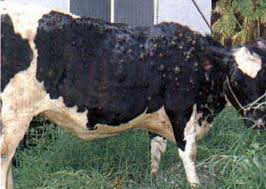LUMPY SKIN DISEASE VIRUS
Lumpy skin disease (LSD) is a viral disease of cattle caused by lumpy skin disease virus (LSDV). LSDV is one of the most important animal poxviruses because of the serious economic consequences in cattle. The World Organization for Animal Health182 categorizes LSD as a notifiable disease.182 It is characterized by fever, reduced milk production and skin nodules. Mastitis, swelling of peripheral lymph nodes, loss of appetite, increased nasal discharge and watery eyes are also common.
ABOUT
LBTOPE (Linear B-cell Epitope)
A method LBtope for predicting linear B-cell epitopes. We developed several models using various techniques (e.g., SVM, IBk)on a large dataset of B-cell epitopes and non-epitopes (12063 epitopes and 20589 non epitopes obtained from IEDB database). First time, experimetally valiadted non B-cell epitopes were used for developing prediction model. In order to provide service to the scientific community, we developed a web server LBtope for predicting and designing B-cell epitopes.
CBTOPE (Conformational B-cell Epitope)
Several methods do exist for the prediction of conformational B cell epitope but they require antigen 3D structure or homology based model of the amino acid sequence. So far no method is available which can predict conformational B cell epitope using antigen primary sequence in the absence of any homology with the known structures. In the present study using amino acid composition as an input feature for Support vector machine (SVM) we developed a model with prediction accuracy of more than 85% and Area under curve (AUC) 0.9.
MHC-1 (Major Histocompatibility complex-1)
MHC class I molecules are one of two primary classes of major histocompatibility complex (MHC) molecules (the other being MHC class II) and are found on the cell surface of all nucleated cells in the bodies of vertebrates. They also occur on platelets, but not on red blood cells. Their function is to display peptide fragments of proteins from within the cell to cytotoxic T cells; this will trigger an immediate response from the immune system against a particular non-self antigen displayed with the help of an MHC class I protein. Because MHC class I molecules present peptides derived from cytosolic proteins, the pathway of MHC class I presentation is often called cytosolic or endogenous pathway.
MHC-2 (Major Histocompatibility complex-2)
MHC Class II molecules are a class of major histocompatibility complex (MHC) molecules normally found only on professional antigen-presenting cells such as dendritic cells, mononuclear phagocytes, some endothelial cells, thymic epithelial cells, and B cells. These cells are important in initiating immune responses.The antigens presented by class II peptides are derived from extracellular proteins (not cytosolic as in MHC class I). Loading of a MHC class II molecule occurs by phagocytosis; extracellular proteins are endocytosed, digested in lysosomes, and the resulting epitopic peptide fragments are loaded onto MHC class II molecules prior to their migration to the cell surface. In humans, the MHC class II protein complex is encoded by the human leukocyte antigen gene complex (HLA). HLAs corresponding to MHC class II are HLA-DP, HLA-DM, HLA-DOA, HLA-DOB, HLA-DQ, and HLA-DR. Mutations in the HLA gene complex can lead to bare lymphocyte syndrome (BLS), which is a type of MHC class II deficiency.

